- 2023년 새해 전망, 주관적 행복감, 핵무기 실사용 위험성 - Gallup International 다국가 조사
- 조사일 : 2022/12/17
- [GallupReport(20221229)_EOY_GIA.pdf] 다운로드
● 2022년 12월 29일(목) 공개 | 문의: 02-3702-2571/2621/2622
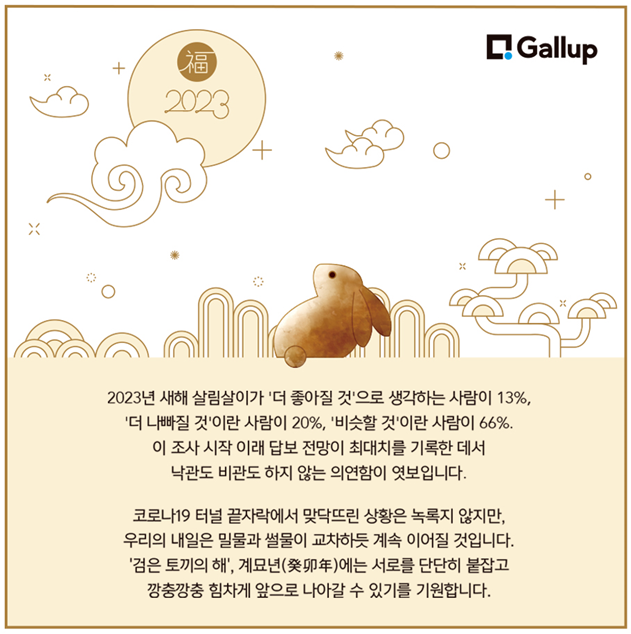
2023년 새해 전망, 행복감, 핵무기 실사용 위험성 인식:
Gallup International 다국가 비교 조사
→ 한국+세계 조사 결과 파일 다운로드(PDF)
/ 세계 조사 개요
- 2022년 10~12월 35개국 성인 총 35,664명 전화/온라인/면접조사(주제별 참여국 상이)
/ 한국 조사 개요
- 조사기간: 2022년 11월 7~24일
- 표본추출: 층화 집락 확률 비례 추출
- 응답방식: 면접조사원 인터뷰(CAPI)
- 조사대상: 전국(제주 제외) 만 19세 이상 1,549명
- 표본오차: ±2.5%포인트(95% 신뢰수준)
- 응답률: 26.7%(총 접촉 5,802명 중 1,549명 응답 완료)
- 의뢰처: 한국갤럽-Gallup International 자체 조사
/ 조사 항목(화살표(→) 옆 단어 클릭하면 해당 위치로 이동)
→ 국가별 2023년 새해 전망 | 자국 경제(경기) 전망
→ 국가별 본인 삶에 대한 주관적 행복감
→ 국가별 핵무기 실사용 위험성 인식
(※ 세계 조사 상세 결과는 첨부 파일 참조)
→ 한국인의 새해 전망 44년간 추이: 경기/살림살이/실업자/노사관계/국제관계
요약
- 2023년 전반적 전망: '좋아질 것' 31%, '나빠질 것' 34%, '올해와 비슷' 27%
- 새해 자국 경제(경기): '좋아질 것' 21%, '나빠질 것' 48%, '올해와 비슷' 24%
- '나의 삶은 행복하다' 54%, '행복하지 않다' 13%, '어느 쪽도 아니다' 31%
- 조사 참여국 행복 순지수 소폭 감소: 작년 44 → 올해 41, 한국 51 → 46
- 핵무기 실사용 '위험성 높다' 38%, '어느 정도 위험' 38%, '위험성 없다' 14%
- 한국인의 새해 경기 낙관론(9%) 작년 대비 급감, 코로나19 첫해와 유사
조사 결과
────────────
국가별 2023년 새해 전망
────────────
'좋아질 것' 31%, '나빠질 것' 34%, '올해와 비슷할 것' 27%
- 낙관론 높은 나라: 나이지리아(77%), 파키스탄(60%)
- 주요국 낙관론: 미국(37%), 독일(26%), 일본·러시아(22%), 한국(12%)
2022년 10~12월 갤럽 인터내셔널이 세계 35개국 성인 35,664명에게 2023년 새해 전망을 물은 결과 '좋아질 것' 31%, '나빠질 것' 34%, '올해와 비슷할 것' 27%로 낙관론과 비관론이 비등해졌다. 1년 전과 비교하면 낙관론이 7%포인트 줄고, 비관론은 7%포인트 늘었다.
◎ 새해 전망을 가장 밝게 보는 나라는 나이지리아로, 77%가 '내년은 올해보다 좋아질 것'이라고 답했다. 파키스탄(60%), 인도(54%), 케냐(53%), 멕시코(51%) 등에서도 낙관론이 50%를 웃돌았다.
◎ 한편, 경제·외교·안보 측면에서 우리나라를 비롯해 우리와 밀접한 관계의 주요국 낙관론은 미국(37%)을 제외하고는 세계 평균에 미치지 못했다: 독일 26%, 일본·러시아 22%, 한국 12%.
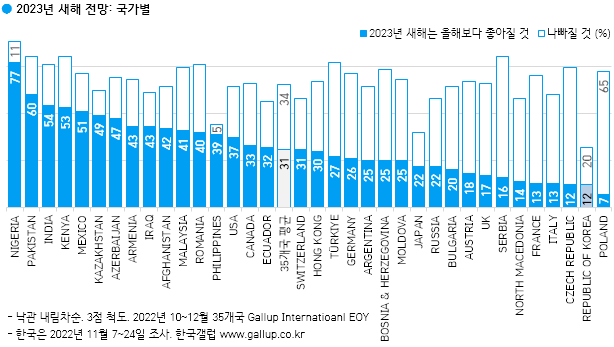
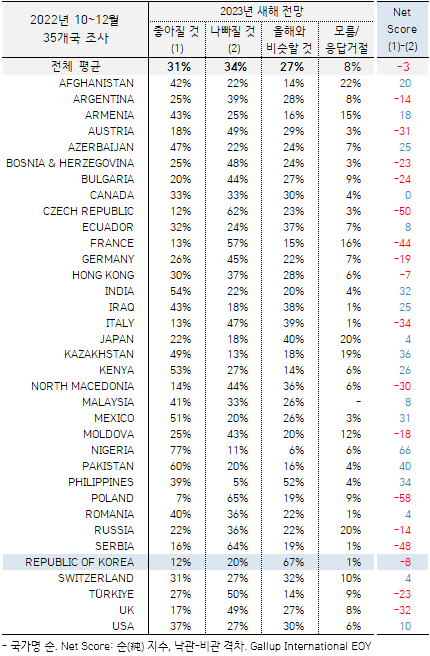
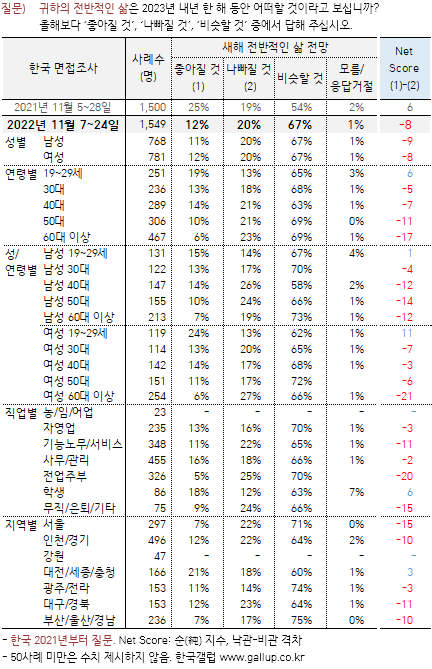
────────────
국가별 새해 경기 전망
────────────
'좋아질 것' 21%, '나빠질 것' 48%, '올해와 비슷할 것' 24%
- 경기 낙관론 높은 나라: 나이지리아(71%), 파키스탄(59%)
- 주요국 경기 낙관론: 미국(21%), 러시아(13%), 일본·영국(10%), 독일·한국(9%)
2023년 새해 자국 경제(경기) 전망을 물은 결과 '좋아질 것' 21%, '나빠질 것' 48%, '올해와 비슷할 것' 24%로 비관론이 낙관론을 앞섰고, 그 격차는 더 커졌다. 1년 전과 비교하면 경기 낙관론이 5%포인트 줄고, 비관론은 7%포인트 늘었다.
◎ 새해 자국 경기를 가장 낙관적으로 보는 나라는 나이지리아로, 71%가 '좋아질 것'이라고 답했다. 파키스탄(59%), 케냐(45%), 아제르바이잔(42%) 등에서도 낙관론이 40%를 웃돌았다. 그 외 주요국 낙관론은 세계 평균과 비슷하거나 그보다 뒤졌다: 미국 21%, 러시아 13%, 일본·영국 10%, 독일·한국 9%.
◎ 이번 조사에 참여한 35개 나라 중 24개국에서 새해 자국 경제가 올해보다 '나빠질 것'이라고 생각하는 사람이 '좋아질 것'이란 사람보다 10%포인트 이상 많았다. 특히 폴란드와 세르비아에서는 새해 자국 경기가 '나빠질 것'이라고 답한 사람이 각각 76%로, 가장 전망이 어두웠다. 오스트리아·독일(73%), 보스니아헤르체고비나(71%), 체코(70%), 영국(67%) 등에서도 비관론이 70% 안팎이었다.
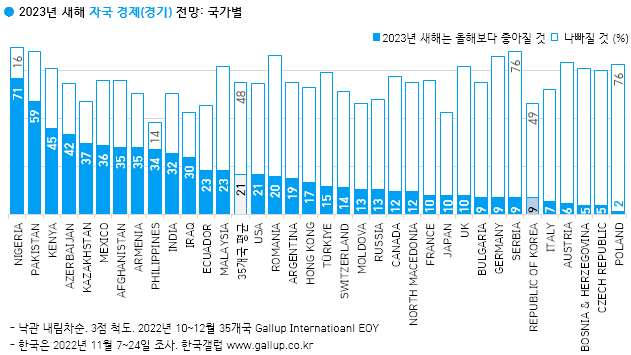
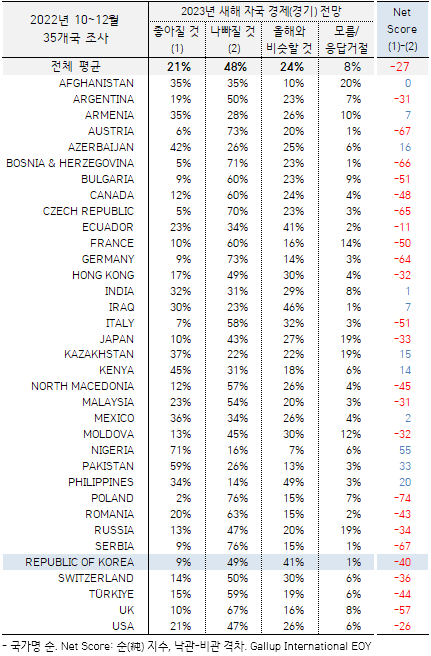
────────────
국가별 주관적 행복감
────────────
'나의 삶은 행복하다' 54%, '행복하지 않다' 13%, '어느 쪽도 아니다' 31%
- '행복하다' 응답 많은 나라: 필리핀(82%), 아프가니스탄(74%)
- 주요국 '행복하다' 응답: 일본(60%), 미국, 한국(50%대), 영국, 독일, 러시아(40%대)
- 행복 순지수: 2020년 40 → 2021년 44 → 2022년 41, 한국 43 → 51 → 46
본인의 삶이 얼마나 행복하다고 생각하는지, 혹은 행복하지 않다고 생각하는지 물었다(5점 척도). 그 결과 조사 참여국 성인 중 54%가 자기 삶이 '행복하다', 13%는 '행복하지 않다', 31%는 '어느 쪽이라고 말할 수 없다'라고 답했다. 1년 전('행복하다' 57%, '행복하지 않다' 13%, '어느 쪽도 아니다' 28%: 44개국 조사)과 비교하면 '행복하다'는 응답이 3%포인트 줄고, '행복하지 않다'는 변함없었다.
◎ 한국인 중에서는 51%가 본인의 삶이 '행복하다', 5%가 '행복하지 않다', 44%가 '어느 쪽도 아니다'라고 답했다. 작년 대비 '행복하다'는 응답이 6%포인트 줄어, 코로나19 팬데믹 첫해인 2020년과 비슷해졌다.
◎ 삶에 대한 주관적 행복감을 순(純)지수(Net Score: 행복-비행복 응답 차이) 기준으로 보면 35개국 중 필리핀(75)이 가장 높고 멕시코(63), 아프가니스탄·에쿠아도르·일본(57)이 뒤이었다. 반면 주관적 행복감 순지수가 가장 낮은 나라는 튀르키예·몰도바(17), 아르헨티나(21), 홍콩(23) 순이다.
그 외 주요국 행복감 순지수는 선행 질문의 새해 전망, 경기 전망보다 널리 분포했다: 주요국 순지수 한국 46, 미국 38, 독일 34, 러시아 30.
◎ 주관적 행복감 순지수를 조사 참여국 전체 응답자 특성별로 보면 성별 차이는 크지 않고(남성 42, 여성 38), 고령층에서 낮은 편이다(25~34세 47; 45~54세 38; 65세 이상 32). 한국인의 행복감 순지수도 고령층에서 낮지만(19~29세 59; 40대 49; 60대 이상 36), 여성(51)이 남성(43)보다 높다는 점에서 달랐다. 2019~2021년도 마찬가지 경향이었다.
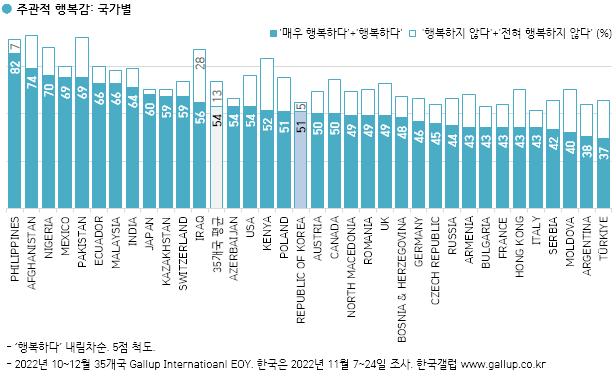
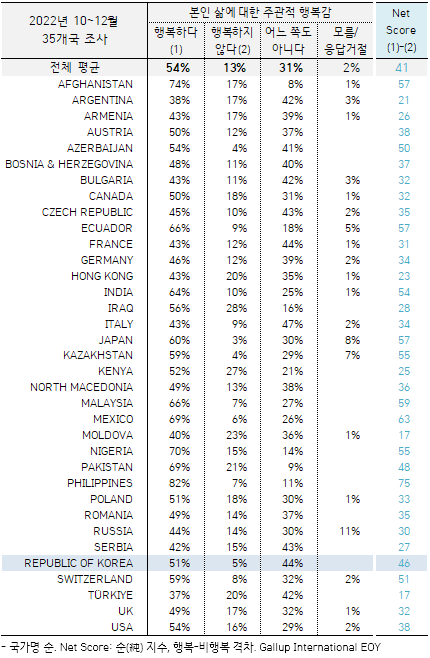
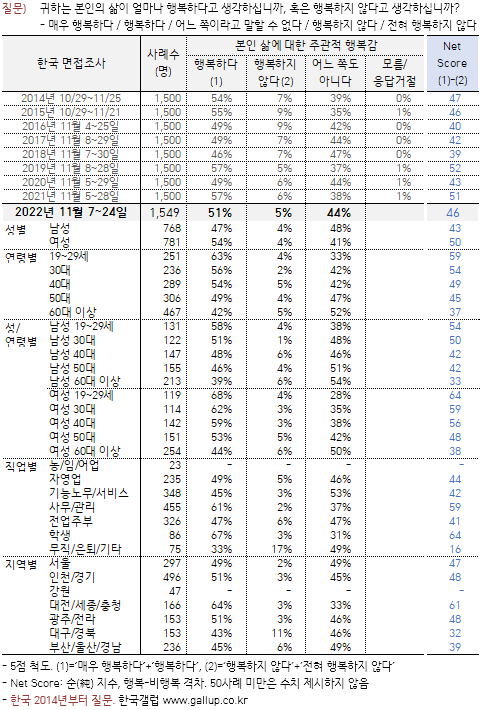
────────────
국가별 핵무기 실사용 위험성 인식
────────────
'위험성 높다' 38%, '어느 정도 위험' 38%, '위험성 없다' 14%
- 고(高)위험 응답 많은 나라: 이라크(88%), 나이지리아(72%)
- 주요국 고위험 응답: 미국(27%), 독일(26%), 러시아(25%), 한국(18%)
2022년 10~12월 갤럽 인터내셔널이 세계 32개국 성인 32,683명에게 오늘날 핵무기가 실제로 사용될 위험성이 어느 정도라고 보는지 물은 결과, '위험성 높다'와 '어느 정도 있다'가 각각 38%로 넷 중 세 명(76%)이 위험성 있다고 봤고 14%는 '위험성 없다'고 답했다. 10%는 의견을 유보했다.
◎ 핵무기 실사용(實使用) 우려감이 가장 큰 나라는 이라크로, 88%가 '위험성 높다'(이하 '고위험')고 답했다. 나이지리아(72%), 필리핀(67%), 케냐·말레이시아(61%), 북마케도니아(58%), 멕시코(56%), 루마니아(53%) 등에서도 50%를 웃돌았다.
◎ 그 외 주요국의 핵무기 실사용 고위험 응답은 미국 27%, 독일 26%, 러시아 25%, 영국 23% 등이다. 한편, 우리나라는 접경지 북한으로부터 수시로 핵 위협을 받지만 핵무기 실사용 고위험 응답은 18%로 32개국 중 최저 수준이다.
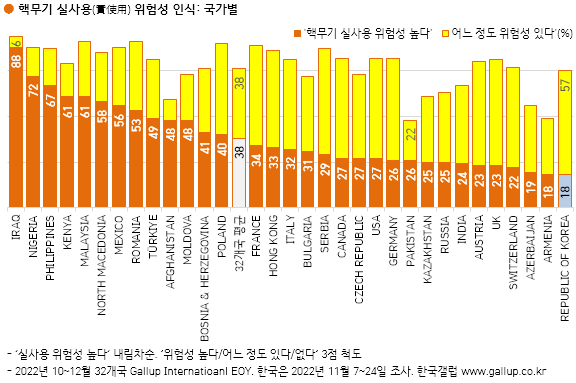
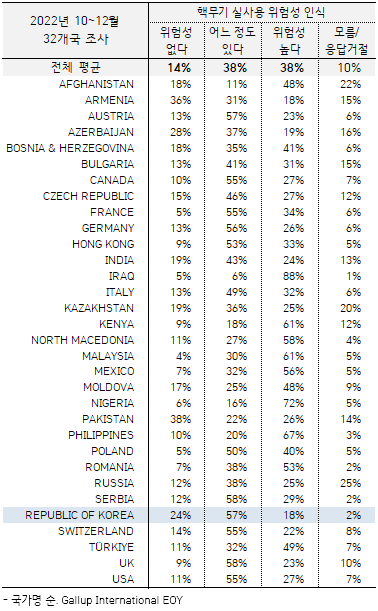
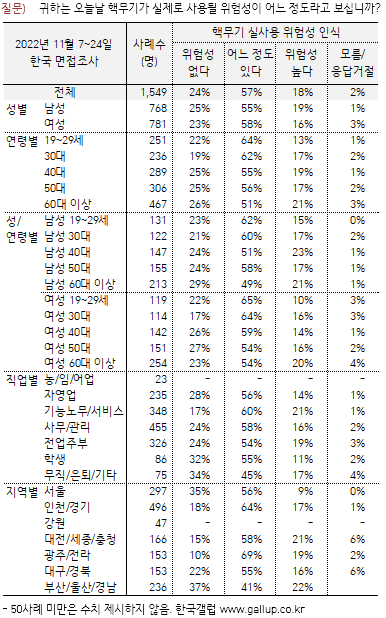
────────────
한국인의 새해 전망: 경기/살림살이/실업자/노사관계/국제관계
────────────
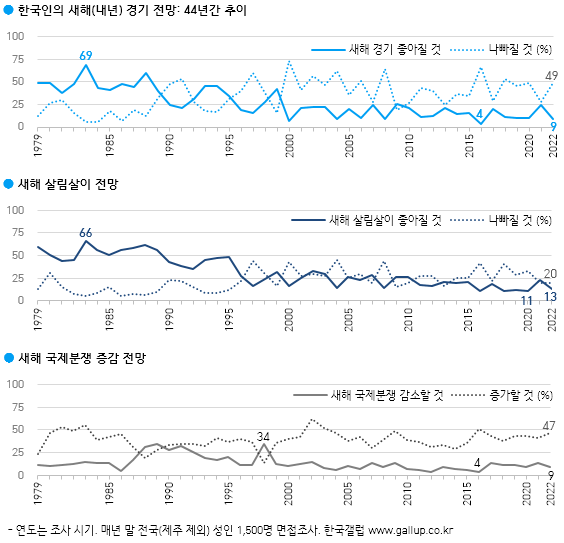
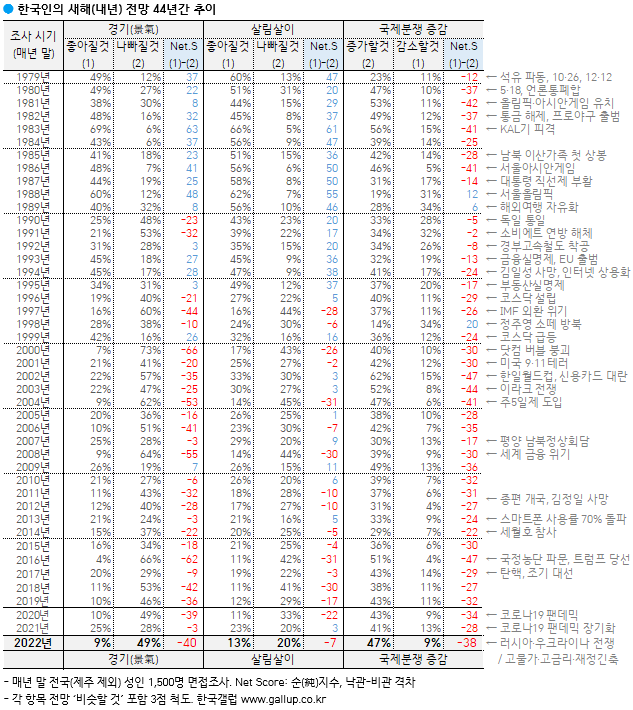
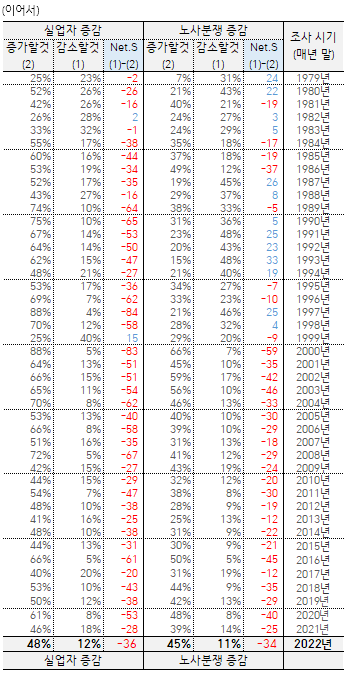
__
한국인의 2023년 새해 국가 경제 전망:
'좋아질 것' 9%, '나빠질 것' 49%, '올해와 비슷할 것' 41%
- 경기 낙관론 작년 대비 16%포인트 감소, 코로나19 첫해와 유사
한국갤럽이 2022년 11월 7~24일 전국(제주 제외)의 만 19세 이상 1,549명에게 새해 우리나라 경제가 어떠할 것이라고 보는지 물었다. 그 결과, 한국 성인 중 9%만 '좋아질 것', 49%는 '나빠질 것', 41%는 '올해와 비슷할 것'이라고 답했다. 새해 경기 낙관론은 작년 대비 16%포인트 감소, 비관론은 21%포인트 증가했다. 이는 코로나19 첫해 2020년 말, 즉 백신 개발 전 새해 전망과 유사하다.
◎ 코로나19 팬데믹에서 엔데믹으로 일상회복 중이지만 올 초 러시아·우크라이나 전쟁에서 비롯한 에너지난과 각국의 급격한 재정 긴축 기조, 국내 부동산 거래 급감과 시세 하락 등은 향후 장기적 경기 침체의 전조로 해석되고 있다.
◎ 과거 한국인의 경기 전망 추이를 보면, 1980년대는 주로 낙관론이 비관론을 크게 앞섰으나 1990년대는 낙관과 비관 우세가 교차 혼재했고 2000년대 들어서는 대체로 비관론이 우세했다. 1979년부터 2022년까지 44년간 조사 중 '새해 경기가 좋아질 것'이란 낙관론 최고치는 1983년의 69%, 최저치는 국정농단 파문이 거셌던 2016년의 4%다.
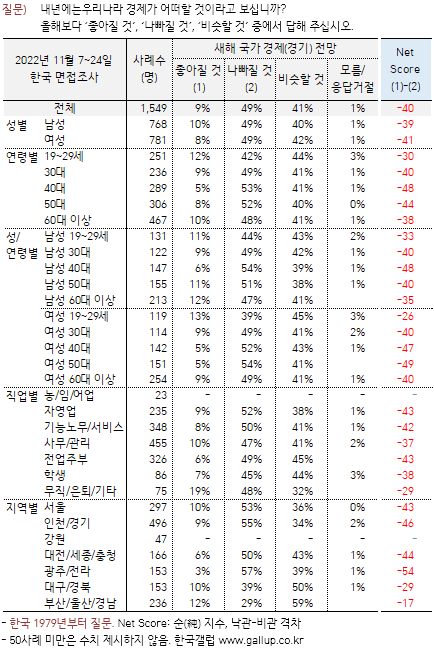
─
한국인의 새해 살림살이 전망:
'좋아질 것' 13%, '나빠질 것' 20%, '올해와 비슷할 것' 66%
- 살림살이 낙관론 작년 대비 10%포인트 감소
살림살이 전망에 대해서는 한국인의 13%가 '올해보다 좋아질 것', 20%는 '나빠질 것', 66%는 '올해와 비슷할 것'이라고 답했다. 살림살이 낙관론은 작년 대비 10%포인트 감소했고, 비관론은 변함없었다.
◎ 과거 한국인의 살림살이 전망 추이를 보면, 1980년대 낙관론이 50%를 넘었고 1990년대 들어서는 소폭 하락했으나 그래도 비관론보다는 낙관론이 많았다. 그러나 1997년 IMF를 기점으로 비관론이 40%를 웃돈 이후로는 낙관론이 비관론을 크게 앞선 해가 없다. 2010년대 들어서는 새해 살림살이가 '올해와 비슷할 것'이라는 응답이 대체로 50%를 웃돌며, 이번 조사에서는 최대치(66%)를 기록했다.
◎ 2010년 이후 낙관-비관 격차가 줄고 한국인 과반이 '새해 살림살이도 올해와 비슷할 것'이라고 전망하는 현상은 '지금보다 더 나빠지지 않으면 다행'이라는 인식, 즉 고령화와 저성장 기조 고착에 따른 변화를 불가피한 현실로 받아들였다고 볼 수 있다. 지난 44년간 조사 중 새해 살림살이 낙관론 최고치는 1983년의 66%, 최저치는 2016년·2018년·2020년의 11%다.
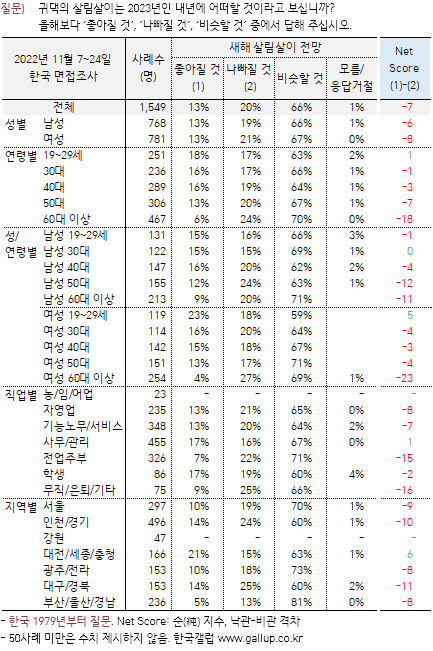
─
한국인의 국제관계 전망:
냉전 종식 1990년 전후 긍정적, 세계화·초연결 2000년대 들어 비관적
- 실업·노사관계 전망, 작년보다 부정적
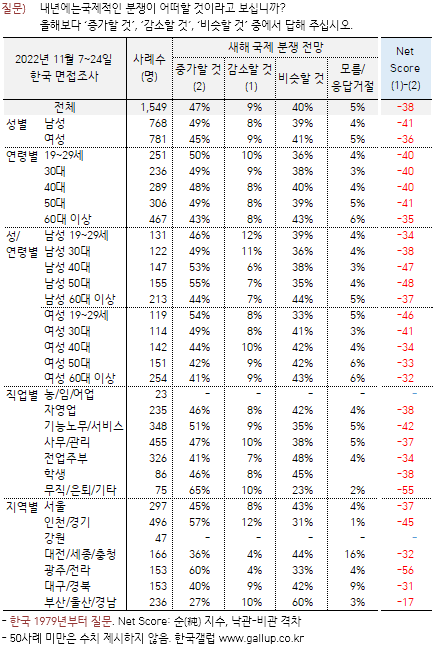
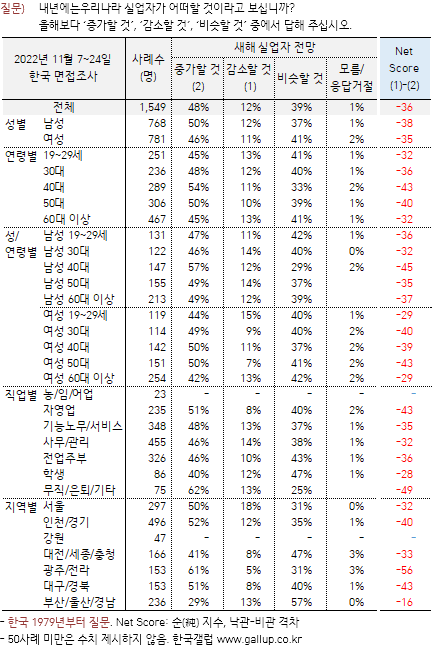
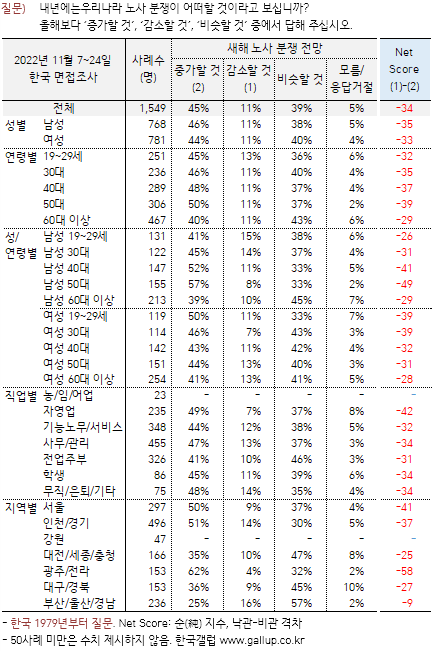
──────────────────
At the End of 2022:
Some Happiness Only Prevails in Private Life,
not in Public Sphere Anymore
──────────────────
At the eve of 2023 public expectations for the future across the Globe are unusually diverse and the World looks much less unified than in previous years. Pessimism is prevailing, the economic prosperity seems to vanish and fears of a use of nuclear weapons are at unprecedented levels. Although personal happiness traditionally prevails, the World as a hole declares less individual happiness. These are some of the findings of End of Year Gallup International Association survey – the polling tradition of the recent decades.
2023 comes with rather pessimistic expectations. Less than a third (31%) of respondents believe that 2023 will be better than 2022. 34% share the opposite opinion and 27% believe 2023 will be the same. The results show more pessimism when compared to the last years and the picture now is similar to the attitudes at the end of 2008, which was the year with the largest pessimism around the world in the new century.
Most optimistic about future are people in Nigeria, Pakistan, Kazakhstan, Philippines and India. At the end of this year top 5 pessimistic countries are fully European – Poland, Czech Republic, Serbia, France and Italy.
Traditionally Russia is rather on the pessimistic side. This year 22% of the respondents there said that they are optimistic about the future, 36% however are pessimistic about 2023 being better than 2022 and 20% are neutral about their expectations. Relatively significant share of the Russians finds it difficult to shape an opinion about the prospects for 2023 – 20%. For the last few years these attitudes remain stable. It should be noted however that there seems to be growth in the share of answers “do not know”.
In the USA on the other hand there has been dramatical shift towards pessimism in the last few years. The optimists today about a better new year are still more than the pessimists – 37% expect 2023 to be better than 2022 and 27% are prepared for a worse year. Neutrals are a nearly third of the respondents and 6% cannot form an opinion. Last year optimists in the USA were 40% and pessimists – 19%. In 2020 59% of the Americans were expecting a better year and 16% were pessimists.
Expectations about the economy also show ongoing growth of anxiety. Now 21% of the people expect economic prosperity for their country in the year to come, near a half (48%) are prepared for economic difficulties and a fourth think that 2023 will be the same as 2022. The rest cannot assess.
This pattern continues the ongoing negative trend about hopes for economic prosperity, which began a few years ago – in 2016 a breaking point was observed and 2020 with Covid-19 pandemic seemed to be the year with worst expectations after the crisis in 2008. But now attitudes seem much like or even worse than those at the end of 2020. Still, world is not so negative in economic expectations than it was in 2008 with its crisis.
Again, nations of global South and East are among top 5 optimists for economic prosperity: Nigeria, Pakistan, Kenya, Azerbaijan, Kazakhstan. Europe again stands out as the most pessimistic region in terms of economy: Poland, Serbia, Germany, Bosnia & Herzegovina, Czech Republic, Romania.
Both USA and Russia share equal shares of respondents who expect economic difficulties (47%). In the USA however the share of those who are expecting prosperity is a bit larger – 21% of the respondents. Russians think about economy with more hesitance – 13% there expect prosperity for 2023. The attitudes towards economy remain negative for the last few years. Last year Russians were even more pessimistic in this regard, while in the USA there is a slight shift towards more negativity this year.
Hopes for the world and its economy might be in decline, but personal happiness still prevails. However, it seems to be in continuous decline over recent years. The majority (54%) of the people in different nations across the globe consider themselves rather happy or even very happy. Over a tenth consider themselves very unhappy or unhappy and a third are neither happy nor unhappy.
Again, countries in East and South are among the top 5 happy nations: Philippines, Mexico, Malaysia, Afghanistan, Ecuador, Japan, and Kazakhstan. Europe is on the gloomier side; however, the unhappier countries are spread across the Globe: Armenia, Kenya, Hong Kong, Argentina, Turkey and Moldova. This comes again as a confirmation that perceptions of happiness have a different origin – dependent on individual circumstances and national context.
Despite being anxious about the future and the economy, people in USA declare that they are rather happy – 54%. Unhappy their claim to be 16%. In Russia 44% of the respondents regard themselves as a happy persons and 14% say that they are unhappy about their live. Both countries have a share of about a third of people who are neither happy, nor unhappy.
The two countries however differ in their perceptions for the last few years: in the USA the share of those, who feel happy about their lives, is progressively shrinking over the recent few years, while in Russia the attitudes remain rather stable. Russians show even a slightly more cheerful answers this year.
There is however a new and heavy shadow, which came with the war of 2022. At the end of 2022 38% of people around the globe see a high risk of use of nuclear weapon nowadays. Another 38% think that there is a moderate risk and just 14% see no risk of nuclear weapon being used any time soon.
People in Iraq, Nigeria, Philippines, Kenya are overall the most concerned of the possibility of someone using a nuclear bomb. Answers in societies closer to the war in Ukraine are a bit different. Most calm are people in Pakistan, Armenia, Azerbaijan, Republic of Korea, Kazakhstan and India.
Fear of nuclear weapon use is rather moderate in the United States – 27% there say that the risk is high and 55% assess it as moderate. 11% see no risk of nuclear weapons being used nowadays. In Russia the attitudes are similar, although relatively calmer – a fourth of the respondents there fear that the risk of using nuclear weapon is high, 38% see a moderate risk and 12% see no risk.
Kancho Stoychev,
President of Gallup International Association:
“The so-called collective West is no longer a nest of optimism and prosperity growth as usually in the past according to its inhabitants. More and more people understand that the war is not near Europe – the war is in Europe. And the European Community is a project for peace first of all. Will it survive in the next 2023 year is under a serious question mark.”
───
한국 응답자 특성표
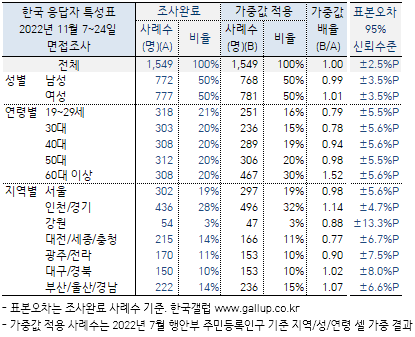
| 1947년 조지 갤럽 박사가 설립한 갤럽 인터내셔널(Gallup International Association)은 1977년부터 전 세계 회원사들이 매년 말 자국민을 대상으로 경제, 노동, 국제 관계 등 현안에 대한 인식과 새해 전망을 알아보는 〈End of Year Survey〉를 해왔습니다. → Press release for the 120th Anniversary of Dr. George Gallup ● 한국갤럽은 1979년부터 44년간 이 조사에 참여하며, 매년 한국인의 새해 전망을 연하장에 담아왔습니다. 아래 이미지를 클릭하시면 전면을 보실 수 있습니다(실물 크기: 가로 80cm, 세로 15cm). |

2023년 새해 전망, 행복감, 핵무기 실사용 위험성 인식:
Gallup International 다국가 비교 조사
→ 한국+세계 조사 결과 파일 다운로드(PDF)
/ 세계 조사 개요
- 2022년 10~12월 35개국 성인 총 35,664명 전화/온라인/면접조사(주제별 참여국 상이)
/ 한국 조사 개요
- 조사기간: 2022년 11월 7~24일
- 표본추출: 층화 집락 확률 비례 추출
- 응답방식: 면접조사원 인터뷰(CAPI)
- 조사대상: 전국(제주 제외) 만 19세 이상 1,549명
- 표본오차: ±2.5%포인트(95% 신뢰수준)
- 응답률: 26.7%(총 접촉 5,802명 중 1,549명 응답 완료)
- 의뢰처: 한국갤럽-Gallup International 자체 조사
/ 조사 항목(화살표(→) 옆 단어 클릭하면 해당 위치로 이동)
→ 국가별 2023년 새해 전망 | 자국 경제(경기) 전망
→ 국가별 본인 삶에 대한 주관적 행복감
→ 국가별 핵무기 실사용 위험성 인식
(※ 세계 조사 상세 결과는 첨부 파일 참조)
→ 한국인의 새해 전망 44년간 추이: 경기/살림살이/실업자/노사관계/국제관계
요약
- 2023년 전반적 전망: '좋아질 것' 31%, '나빠질 것' 34%, '올해와 비슷' 27%
- 새해 자국 경제(경기): '좋아질 것' 21%, '나빠질 것' 48%, '올해와 비슷' 24%
- '나의 삶은 행복하다' 54%, '행복하지 않다' 13%, '어느 쪽도 아니다' 31%
- 조사 참여국 행복 순지수 소폭 감소: 작년 44 → 올해 41, 한국 51 → 46
- 핵무기 실사용 '위험성 높다' 38%, '어느 정도 위험' 38%, '위험성 없다' 14%
- 한국인의 새해 경기 낙관론(9%) 작년 대비 급감, 코로나19 첫해와 유사
조사 결과
────────────
국가별 2023년 새해 전망
────────────
'좋아질 것' 31%, '나빠질 것' 34%, '올해와 비슷할 것' 27%
- 낙관론 높은 나라: 나이지리아(77%), 파키스탄(60%)
- 주요국 낙관론: 미국(37%), 독일(26%), 일본·러시아(22%), 한국(12%)
2022년 10~12월 갤럽 인터내셔널이 세계 35개국 성인 35,664명에게 2023년 새해 전망을 물은 결과 '좋아질 것' 31%, '나빠질 것' 34%, '올해와 비슷할 것' 27%로 낙관론과 비관론이 비등해졌다. 1년 전과 비교하면 낙관론이 7%포인트 줄고, 비관론은 7%포인트 늘었다.
◎ 새해 전망을 가장 밝게 보는 나라는 나이지리아로, 77%가 '내년은 올해보다 좋아질 것'이라고 답했다. 파키스탄(60%), 인도(54%), 케냐(53%), 멕시코(51%) 등에서도 낙관론이 50%를 웃돌았다.
◎ 한편, 경제·외교·안보 측면에서 우리나라를 비롯해 우리와 밀접한 관계의 주요국 낙관론은 미국(37%)을 제외하고는 세계 평균에 미치지 못했다: 독일 26%, 일본·러시아 22%, 한국 12%.



────────────
국가별 새해 경기 전망
────────────
'좋아질 것' 21%, '나빠질 것' 48%, '올해와 비슷할 것' 24%
- 경기 낙관론 높은 나라: 나이지리아(71%), 파키스탄(59%)
- 주요국 경기 낙관론: 미국(21%), 러시아(13%), 일본·영국(10%), 독일·한국(9%)
2023년 새해 자국 경제(경기) 전망을 물은 결과 '좋아질 것' 21%, '나빠질 것' 48%, '올해와 비슷할 것' 24%로 비관론이 낙관론을 앞섰고, 그 격차는 더 커졌다. 1년 전과 비교하면 경기 낙관론이 5%포인트 줄고, 비관론은 7%포인트 늘었다.
◎ 새해 자국 경기를 가장 낙관적으로 보는 나라는 나이지리아로, 71%가 '좋아질 것'이라고 답했다. 파키스탄(59%), 케냐(45%), 아제르바이잔(42%) 등에서도 낙관론이 40%를 웃돌았다. 그 외 주요국 낙관론은 세계 평균과 비슷하거나 그보다 뒤졌다: 미국 21%, 러시아 13%, 일본·영국 10%, 독일·한국 9%.
◎ 이번 조사에 참여한 35개 나라 중 24개국에서 새해 자국 경제가 올해보다 '나빠질 것'이라고 생각하는 사람이 '좋아질 것'이란 사람보다 10%포인트 이상 많았다. 특히 폴란드와 세르비아에서는 새해 자국 경기가 '나빠질 것'이라고 답한 사람이 각각 76%로, 가장 전망이 어두웠다. 오스트리아·독일(73%), 보스니아헤르체고비나(71%), 체코(70%), 영국(67%) 등에서도 비관론이 70% 안팎이었다.


────────────
국가별 주관적 행복감
────────────
'나의 삶은 행복하다' 54%, '행복하지 않다' 13%, '어느 쪽도 아니다' 31%
- '행복하다' 응답 많은 나라: 필리핀(82%), 아프가니스탄(74%)
- 주요국 '행복하다' 응답: 일본(60%), 미국, 한국(50%대), 영국, 독일, 러시아(40%대)
- 행복 순지수: 2020년 40 → 2021년 44 → 2022년 41, 한국 43 → 51 → 46
본인의 삶이 얼마나 행복하다고 생각하는지, 혹은 행복하지 않다고 생각하는지 물었다(5점 척도). 그 결과 조사 참여국 성인 중 54%가 자기 삶이 '행복하다', 13%는 '행복하지 않다', 31%는 '어느 쪽이라고 말할 수 없다'라고 답했다. 1년 전('행복하다' 57%, '행복하지 않다' 13%, '어느 쪽도 아니다' 28%: 44개국 조사)과 비교하면 '행복하다'는 응답이 3%포인트 줄고, '행복하지 않다'는 변함없었다.
◎ 한국인 중에서는 51%가 본인의 삶이 '행복하다', 5%가 '행복하지 않다', 44%가 '어느 쪽도 아니다'라고 답했다. 작년 대비 '행복하다'는 응답이 6%포인트 줄어, 코로나19 팬데믹 첫해인 2020년과 비슷해졌다.
◎ 삶에 대한 주관적 행복감을 순(純)지수(Net Score: 행복-비행복 응답 차이) 기준으로 보면 35개국 중 필리핀(75)이 가장 높고 멕시코(63), 아프가니스탄·에쿠아도르·일본(57)이 뒤이었다. 반면 주관적 행복감 순지수가 가장 낮은 나라는 튀르키예·몰도바(17), 아르헨티나(21), 홍콩(23) 순이다.
그 외 주요국 행복감 순지수는 선행 질문의 새해 전망, 경기 전망보다 널리 분포했다: 주요국 순지수 한국 46, 미국 38, 독일 34, 러시아 30.
◎ 주관적 행복감 순지수를 조사 참여국 전체 응답자 특성별로 보면 성별 차이는 크지 않고(남성 42, 여성 38), 고령층에서 낮은 편이다(25~34세 47; 45~54세 38; 65세 이상 32). 한국인의 행복감 순지수도 고령층에서 낮지만(19~29세 59; 40대 49; 60대 이상 36), 여성(51)이 남성(43)보다 높다는 점에서 달랐다. 2019~2021년도 마찬가지 경향이었다.



────────────
국가별 핵무기 실사용 위험성 인식
────────────
'위험성 높다' 38%, '어느 정도 위험' 38%, '위험성 없다' 14%
- 고(高)위험 응답 많은 나라: 이라크(88%), 나이지리아(72%)
- 주요국 고위험 응답: 미국(27%), 독일(26%), 러시아(25%), 한국(18%)
2022년 10~12월 갤럽 인터내셔널이 세계 32개국 성인 32,683명에게 오늘날 핵무기가 실제로 사용될 위험성이 어느 정도라고 보는지 물은 결과, '위험성 높다'와 '어느 정도 있다'가 각각 38%로 넷 중 세 명(76%)이 위험성 있다고 봤고 14%는 '위험성 없다'고 답했다. 10%는 의견을 유보했다.
◎ 핵무기 실사용(實使用) 우려감이 가장 큰 나라는 이라크로, 88%가 '위험성 높다'(이하 '고위험')고 답했다. 나이지리아(72%), 필리핀(67%), 케냐·말레이시아(61%), 북마케도니아(58%), 멕시코(56%), 루마니아(53%) 등에서도 50%를 웃돌았다.
◎ 그 외 주요국의 핵무기 실사용 고위험 응답은 미국 27%, 독일 26%, 러시아 25%, 영국 23% 등이다. 한편, 우리나라는 접경지 북한으로부터 수시로 핵 위협을 받지만 핵무기 실사용 고위험 응답은 18%로 32개국 중 최저 수준이다.



────────────
한국인의 새해 전망: 경기/살림살이/실업자/노사관계/국제관계
────────────



__
한국인의 2023년 새해 국가 경제 전망:
'좋아질 것' 9%, '나빠질 것' 49%, '올해와 비슷할 것' 41%
- 경기 낙관론 작년 대비 16%포인트 감소, 코로나19 첫해와 유사
한국갤럽이 2022년 11월 7~24일 전국(제주 제외)의 만 19세 이상 1,549명에게 새해 우리나라 경제가 어떠할 것이라고 보는지 물었다. 그 결과, 한국 성인 중 9%만 '좋아질 것', 49%는 '나빠질 것', 41%는 '올해와 비슷할 것'이라고 답했다. 새해 경기 낙관론은 작년 대비 16%포인트 감소, 비관론은 21%포인트 증가했다. 이는 코로나19 첫해 2020년 말, 즉 백신 개발 전 새해 전망과 유사하다.
◎ 코로나19 팬데믹에서 엔데믹으로 일상회복 중이지만 올 초 러시아·우크라이나 전쟁에서 비롯한 에너지난과 각국의 급격한 재정 긴축 기조, 국내 부동산 거래 급감과 시세 하락 등은 향후 장기적 경기 침체의 전조로 해석되고 있다.
◎ 과거 한국인의 경기 전망 추이를 보면, 1980년대는 주로 낙관론이 비관론을 크게 앞섰으나 1990년대는 낙관과 비관 우세가 교차 혼재했고 2000년대 들어서는 대체로 비관론이 우세했다. 1979년부터 2022년까지 44년간 조사 중 '새해 경기가 좋아질 것'이란 낙관론 최고치는 1983년의 69%, 최저치는 국정농단 파문이 거셌던 2016년의 4%다.

─
한국인의 새해 살림살이 전망:
'좋아질 것' 13%, '나빠질 것' 20%, '올해와 비슷할 것' 66%
- 살림살이 낙관론 작년 대비 10%포인트 감소
살림살이 전망에 대해서는 한국인의 13%가 '올해보다 좋아질 것', 20%는 '나빠질 것', 66%는 '올해와 비슷할 것'이라고 답했다. 살림살이 낙관론은 작년 대비 10%포인트 감소했고, 비관론은 변함없었다.
◎ 과거 한국인의 살림살이 전망 추이를 보면, 1980년대 낙관론이 50%를 넘었고 1990년대 들어서는 소폭 하락했으나 그래도 비관론보다는 낙관론이 많았다. 그러나 1997년 IMF를 기점으로 비관론이 40%를 웃돈 이후로는 낙관론이 비관론을 크게 앞선 해가 없다. 2010년대 들어서는 새해 살림살이가 '올해와 비슷할 것'이라는 응답이 대체로 50%를 웃돌며, 이번 조사에서는 최대치(66%)를 기록했다.
◎ 2010년 이후 낙관-비관 격차가 줄고 한국인 과반이 '새해 살림살이도 올해와 비슷할 것'이라고 전망하는 현상은 '지금보다 더 나빠지지 않으면 다행'이라는 인식, 즉 고령화와 저성장 기조 고착에 따른 변화를 불가피한 현실로 받아들였다고 볼 수 있다. 지난 44년간 조사 중 새해 살림살이 낙관론 최고치는 1983년의 66%, 최저치는 2016년·2018년·2020년의 11%다.

─
한국인의 국제관계 전망:
냉전 종식 1990년 전후 긍정적, 세계화·초연결 2000년대 들어 비관적
- 실업·노사관계 전망, 작년보다 부정적



──────────────────
At the End of 2022:
Some Happiness Only Prevails in Private Life,
not in Public Sphere Anymore
──────────────────
At the eve of 2023 public expectations for the future across the Globe are unusually diverse and the World looks much less unified than in previous years. Pessimism is prevailing, the economic prosperity seems to vanish and fears of a use of nuclear weapons are at unprecedented levels. Although personal happiness traditionally prevails, the World as a hole declares less individual happiness. These are some of the findings of End of Year Gallup International Association survey – the polling tradition of the recent decades.
2023 comes with rather pessimistic expectations. Less than a third (31%) of respondents believe that 2023 will be better than 2022. 34% share the opposite opinion and 27% believe 2023 will be the same. The results show more pessimism when compared to the last years and the picture now is similar to the attitudes at the end of 2008, which was the year with the largest pessimism around the world in the new century.
Most optimistic about future are people in Nigeria, Pakistan, Kazakhstan, Philippines and India. At the end of this year top 5 pessimistic countries are fully European – Poland, Czech Republic, Serbia, France and Italy.
Traditionally Russia is rather on the pessimistic side. This year 22% of the respondents there said that they are optimistic about the future, 36% however are pessimistic about 2023 being better than 2022 and 20% are neutral about their expectations. Relatively significant share of the Russians finds it difficult to shape an opinion about the prospects for 2023 – 20%. For the last few years these attitudes remain stable. It should be noted however that there seems to be growth in the share of answers “do not know”.
In the USA on the other hand there has been dramatical shift towards pessimism in the last few years. The optimists today about a better new year are still more than the pessimists – 37% expect 2023 to be better than 2022 and 27% are prepared for a worse year. Neutrals are a nearly third of the respondents and 6% cannot form an opinion. Last year optimists in the USA were 40% and pessimists – 19%. In 2020 59% of the Americans were expecting a better year and 16% were pessimists.
Expectations about the economy also show ongoing growth of anxiety. Now 21% of the people expect economic prosperity for their country in the year to come, near a half (48%) are prepared for economic difficulties and a fourth think that 2023 will be the same as 2022. The rest cannot assess.
This pattern continues the ongoing negative trend about hopes for economic prosperity, which began a few years ago – in 2016 a breaking point was observed and 2020 with Covid-19 pandemic seemed to be the year with worst expectations after the crisis in 2008. But now attitudes seem much like or even worse than those at the end of 2020. Still, world is not so negative in economic expectations than it was in 2008 with its crisis.
Again, nations of global South and East are among top 5 optimists for economic prosperity: Nigeria, Pakistan, Kenya, Azerbaijan, Kazakhstan. Europe again stands out as the most pessimistic region in terms of economy: Poland, Serbia, Germany, Bosnia & Herzegovina, Czech Republic, Romania.
Both USA and Russia share equal shares of respondents who expect economic difficulties (47%). In the USA however the share of those who are expecting prosperity is a bit larger – 21% of the respondents. Russians think about economy with more hesitance – 13% there expect prosperity for 2023. The attitudes towards economy remain negative for the last few years. Last year Russians were even more pessimistic in this regard, while in the USA there is a slight shift towards more negativity this year.
Hopes for the world and its economy might be in decline, but personal happiness still prevails. However, it seems to be in continuous decline over recent years. The majority (54%) of the people in different nations across the globe consider themselves rather happy or even very happy. Over a tenth consider themselves very unhappy or unhappy and a third are neither happy nor unhappy.
Again, countries in East and South are among the top 5 happy nations: Philippines, Mexico, Malaysia, Afghanistan, Ecuador, Japan, and Kazakhstan. Europe is on the gloomier side; however, the unhappier countries are spread across the Globe: Armenia, Kenya, Hong Kong, Argentina, Turkey and Moldova. This comes again as a confirmation that perceptions of happiness have a different origin – dependent on individual circumstances and national context.
Despite being anxious about the future and the economy, people in USA declare that they are rather happy – 54%. Unhappy their claim to be 16%. In Russia 44% of the respondents regard themselves as a happy persons and 14% say that they are unhappy about their live. Both countries have a share of about a third of people who are neither happy, nor unhappy.
The two countries however differ in their perceptions for the last few years: in the USA the share of those, who feel happy about their lives, is progressively shrinking over the recent few years, while in Russia the attitudes remain rather stable. Russians show even a slightly more cheerful answers this year.
There is however a new and heavy shadow, which came with the war of 2022. At the end of 2022 38% of people around the globe see a high risk of use of nuclear weapon nowadays. Another 38% think that there is a moderate risk and just 14% see no risk of nuclear weapon being used any time soon.
People in Iraq, Nigeria, Philippines, Kenya are overall the most concerned of the possibility of someone using a nuclear bomb. Answers in societies closer to the war in Ukraine are a bit different. Most calm are people in Pakistan, Armenia, Azerbaijan, Republic of Korea, Kazakhstan and India.
Fear of nuclear weapon use is rather moderate in the United States – 27% there say that the risk is high and 55% assess it as moderate. 11% see no risk of nuclear weapons being used nowadays. In Russia the attitudes are similar, although relatively calmer – a fourth of the respondents there fear that the risk of using nuclear weapon is high, 38% see a moderate risk and 12% see no risk.
Kancho Stoychev,
President of Gallup International Association:
“The so-called collective West is no longer a nest of optimism and prosperity growth as usually in the past according to its inhabitants. More and more people understand that the war is not near Europe – the war is in Europe. And the European Community is a project for peace first of all. Will it survive in the next 2023 year is under a serious question mark.”
───
한국 응답자 특성표
